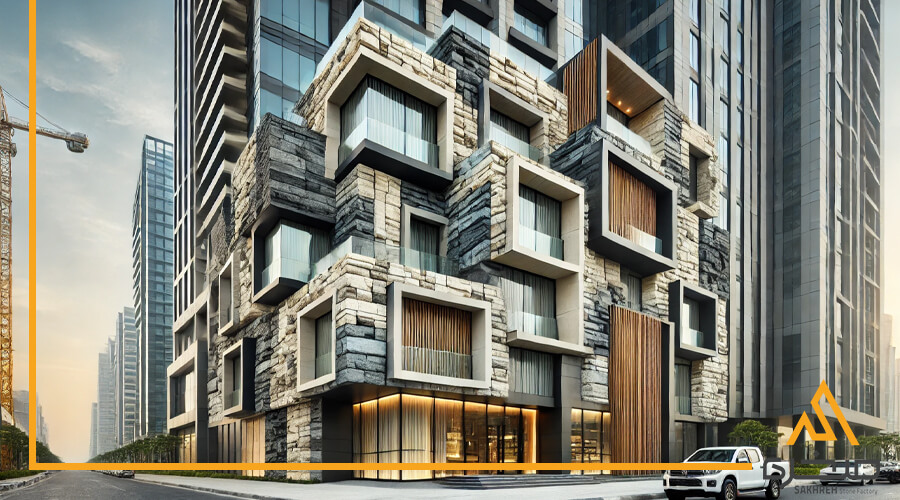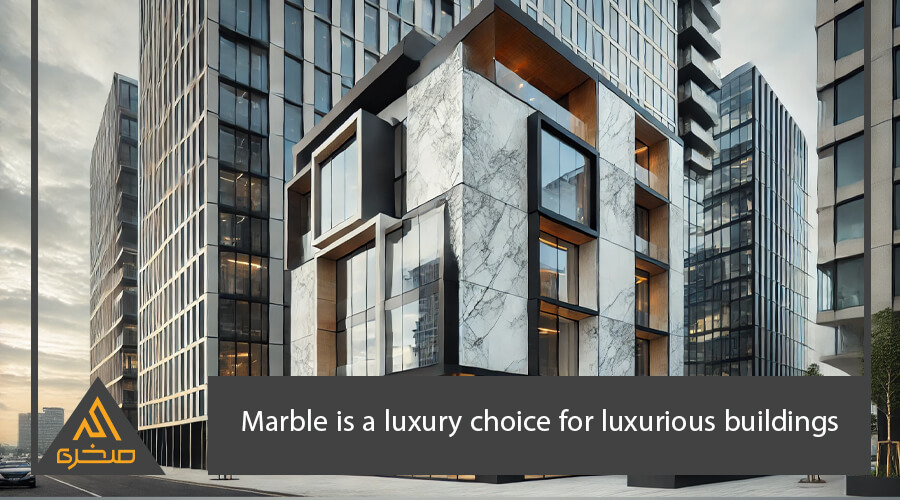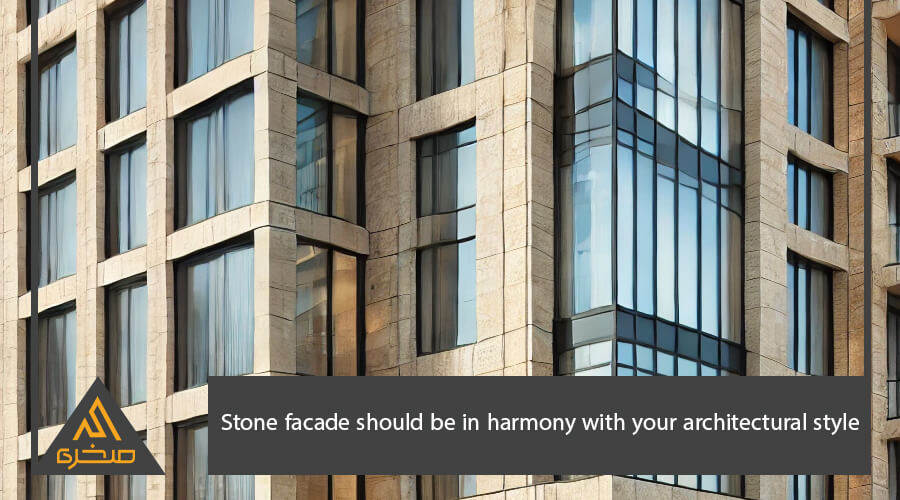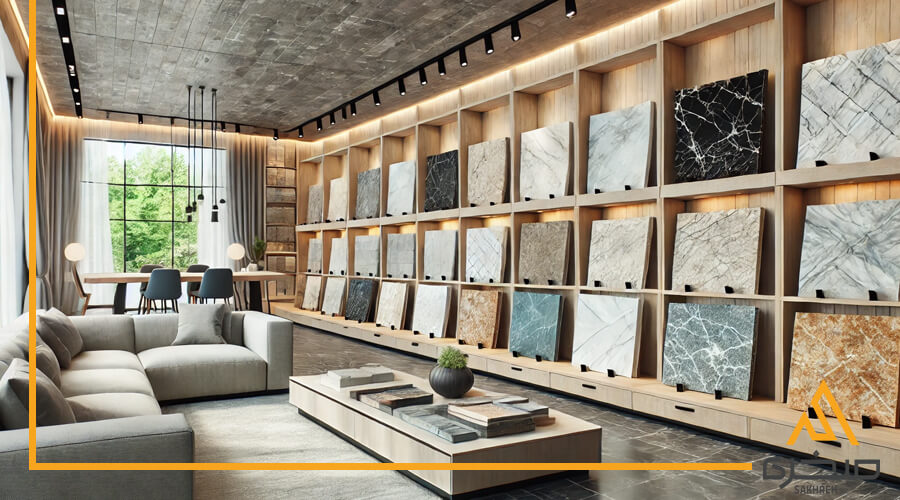- No comments

Comparison of Building Facade Stones +Advantages and Disadvantages Explained
The facade is one of the most essential aspects of a building’s design, not only influencing its aesthetic appeal but also protecting it from environmental factors. Stone is a popular choice for building facades due to its durability, natural beauty, and adaptability to various architectural styles. This article explores the types of stones used in building facades, their features, and applications.
If you are looking to purchase high-quality and diverse building stones, Sakhreh Stone is one of the best options for selecting and buying various types of building stones.
Factors Influencing the Choice of Facade Stones
Selecting the right stone for a building facade depends on several crucial factors:
- Climate Conditions: In regions with heavy rainfall or extreme cold, stones with high resistance to moisture and freezing are essential.
- Architectural Style: For modern designs, simple and minimalistic stones are preferred, whereas textured and natural stones are ideal for classical designs.
- Budget: Stones vary significantly in cost. The chosen stone must align with the available budget.
Types of Stones for Building Facades
1. Travertine
Travertine is one of the most widely used stones for building facades. Its porous texture and warm natural colors add a sense of intimacy and elegance to structures. Travertine’s resistance to temperature changes and strong adhesion make it suitable for areas with variable weather conditions. Additionally, it is versatile for various architectural styles.
2. Granite
Granite is one of the most durable and resilient facade stones. Its high hardness makes it resistant to scratches, heat, and moisture. The granular texture and wide color range make it a popular choice for modern buildings. However, its heavy weight may complicate installation.
3. Marble
Marble is a luxurious choice for facades, known for its natural shine and elegance. Available in diverse colors like white, cream, green, and black, marble adds a unique charm to buildings. However, it requires meticulous maintenance and may be vulnerable to harsh environmental conditions.

4. Sandstone
Sandstone is a natural stone with unique textures and colors, making it ideal for creative and distinctive facades. It is easy to cut and shape, making it suitable for both interior and exterior villa designs. However, it requires additional protection against moisture.
5. Crystal (Chinese Stone)
Crystal stone, also known as Chinese stone, is a natural material with a smooth surface and light colors. Its high resistance to environmental factors makes it suitable for regions with heavy rainfall and harsh weather conditions. Its smooth finish and bright appearance are ideal for modern facades.
6. Basalt
Basalt is a volcanic stone with a dark and matte appearance, often used in industrial and modern designs. Its high resistance to impact and environmental stress, along with its neutral color, allows it to blend well with other architectural elements.
7. Antique Stone
Antique stone is made from small pieces of natural stones and is used for decorative facades. Its artistic and unique designs make it more common in classical or rustic-style buildings.

Comparison of Facade Stones
| Features | Travertine | Granite | Marble | Sandstone | Crystal Stone | Basalt | Antique Stone |
|---|---|---|---|---|---|---|---|
| Durability | Moderate, freeze-resistant | Very high resistance to scratches and heat | Moderate, sensitive to harsh conditions | Moderate, sensitive to moisture | High resistance to environmental factors | Very high resistance to impact and stress | Moderate, suitable for decorative use |
| Aesthetics | Warm natural colors | Granular and modern | Glossy and luxurious with natural veins | Unique texture and natural look | Smooth surface and light colors | Matte and dark, ideal for industrial designs | Artistic and unique, classic appeal |
| Cost | Affordable | Relatively high | Expensive | Affordable | Moderate | Moderate to high | Variable depending on design |
| Maintenance | Easy, may require waterproofing | Easy | Requires regular care | Needs protection from moisture | Easy | Easy | Requires attention to installation and cleaning |
| Applications | Exterior facades, interior walls | Modern facades, high-traffic areas | Luxurious buildings | Creative villas | Modern facades, rainy regions | Industrial and modern designs | Decorative interior and exterior facades |
Ideas for Combining Stones in Facade Design
Combining multiple types of stones in a building facade is a creative approach to achieving a unique and eye-catching appearance. This method allows designers to play with colors, textures, and patterns to create stunning and distinctive structures. Blending stones can work in modern, classical, or even industrial styles, giving the building a specific identity.
– Travertine and Granite Combination
Using warm-colored travertine for the main facade and dark granite for framing doors and windows creates a striking contrast, suitable for classical and formal buildings.

– Marble and Basalt Combination
White or cream marble can be used for prominent facade features like columns, while dark basalt serves as a backdrop. This blend is ideal for creating a luxurious and modern appearance.
– Antique Stone for Decorative Elements
Adding antique stone to simple facades made of sandstone or travertine can create an artistic and unique look, especially for trims or engravings.
– Contrasting Colors
Pairing light stones like crystal stone with dark ones like granite or basalt creates visual contrast, resulting in a dynamic and eye-catching facade.
– Natural and Artificial Stone Mix
Using natural stones for main sections and artificial stones for decorative details not only reduces costs but also enables more intricate designs.

conclusion
In this article from the Sakhreh blog, we explored how building stones, due to their high diversity, durability, and beauty, are among the primary choices in architectural and construction projects. Each stone, such as durable granite, marble, and travertine, has unique characteristics that make it suitable for specific applications. An informed selection of stone can have a significant impact on the longevity and appeal of a project.
New Articles



